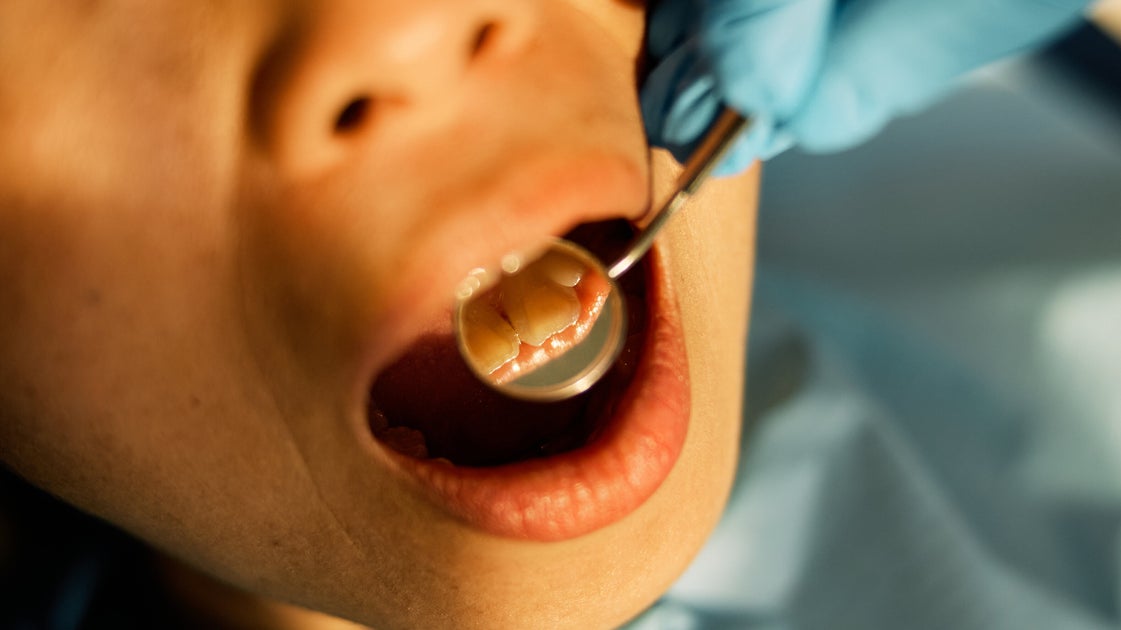
Roughly one-third of adults in the United States regularly floss, which is not good news for your teeth, gums or dental bill.
A proper dental routine, which includes brushing and flossing, can help keep dental issues like gum disease away.
“Most people don’t realize that gum disease is an infection of the tissues that support our teeth, and it’s caused by a buildup of plaque,” said Dr. Rachel Thelen, a dental hygienist and clinical associate professor at the University of Minnesota School of Dentistry.
“When that plaque is not removed, it can cause infection and inflammation,” she noted.
Technically, gum disease is a catch-all term that describes a few conditions. “So, many people have probably heard of gingivitis, so that’s one of them, then we also have periodontitis,” explained Thelen.
Gum disease starts as gingivitis, but when that’s left untreated, it can progress to periodontitis, she added.
“Gingivitis, which is pretty routine, [is] a mild form of gum inflammation, and this is reversible,” said Dr. Albert Coombs, the owner of Smile Services DC and a member of the International Dental Implant Association.
Most folks will even develop mild gingivitis in between dentist visits, he noted. But what you don’t want is for it to progress and cause lasting dental damage. Here’s what to know:
There are clear signs of gum disease.
Bleeding when brushing or flossing is a major sign of both gingivitis and periodontitis, said Thelen.
“I always like to reiterate to my patients that if you’re seeing bleeding, that’s not normal, healthy gums should not bleed,” Thelen added.
“Red gums, swollen gums, gums that are very tender” are also symptoms, Coombs said.
As the disease progresses, there can be gum recession and, sometimes, pus between the gums and the teeth.
Persistent bad breath that isn’t remedied by brushing is a sign of both gingivitis and periodontitis, said Coombs. But Thelen noted it tends to be more common with periodontitis.
“And then also shifting of teeth. Now, shifting of teeth is more when you have periodontitis, when you start to lose bone around the teeth. That’s a huge, huge sign,” Coombs noted. Tooth loss is also a sign of periodontitis, Thelen noted.
Carol Yepes via Getty Images
There are treatments for both forms of gum disease, but it’s important to see your dentist as soon as you can.
Once again, gingivitis is reversible and treatable.
“In that gingivitis stage, treatment is going to consist more of a dental cleaning by your licensed dental hygienist, and then they will help you find changes … to your oral hygiene habits at home, such as your brushing technique and flossing,” said Thelen.
While periodontitis isn’t reversible, there are still treatments available, both experts told HuffPost. Specifically, you (with the help of a dentist) can stop periodontitis from progressing, Coombs noted.
“You may have lost bone, but you can clean everything out — this is otherwise known as deep cleanings — so that you don’t lose any more bone,” Coombs said. Formally, this is an in-office procedure that’s known as scaling and root planing, Thelen added.
“Your hygienist is going to clean below the gum line to remove plaque and tartar because those are irritants in the gum pocket,” Thelen said.
It’ll then be recommended that you come in for maintenance cleanings every three to four months, instead of the typical six months, to make sure your gums and teeth stay healthy, she noted.
“Then, when we have more severe cases, seeing a specialist called a periodontist might be needed for more advanced treatment,” Thelen said.
Some folks are at higher risk of developing gum disease.
“Gum disease is quite common in the United States,” Thelen said.
“The CDC says that 47% of adults 30 and older have periodontitis… and from the most recent [National Health and Nutrition Examination Survey], they’ve actually estimated, overall, that 80% of people will experience some kind of gum disease, whether that’s gingivitis or periodontitis, at some point in their life,” added Thelen.
While it’s likely to affect most people in their lifetime, certain groups of people are at higher risk of gum disease, experts say. This includes smokers, people who are diabetic, pre-diabetic and pregnant folks, Coombs said.
A gum disease diagnosis shouldn’t embarrass you; instead, it should inspire you to update your dental hygiene routine.
Here’s what you can do to keep your teeth and gums healthy.
Coombs said that most chronic dental problems, such as decay and tooth loss, tend to start with gum disease or gingivitis.
“It just kind of creates a haven for bacteria to build up and cause cavities. So it is one of those things where most people, I usually say, if you brush, floss and rinse twice a day, every single day, most of your dental appointments are going to be pretty boring,” Coombs said.
While certain conditions beyond hygiene issues can cause tooth and gum problems, “for the most part, if you are doing proper hygiene, you can avoid a lot of these dental problems,” he added.
Along with daily brushing and flossing, you’ll want to go in for regular dental cleanings, which are normally every six months but can be more frequent for those with gum disease. You should talk to your dentist to figure out the best cadence for you.
If you haven’t been to the dentist for quite some time, it’s important to get back on track, noted Coombs.
Gum disease is associated with other systemic diseases, such as heart disease, said Thelen. This is specifically true for periodontal disease, according to the Cleveland Clinic.
“It’s more so due to the inflammatory nature of the disease. So, our mouth and our body, everything’s connected. When there’s inflammation and disease going on in our mouth that can affect other systems as well,” added Thelen.
While gum disease is common, it shouldn’t be ignored, Thelen noted. Not only can it lead to issues like tooth loss and receding gums, but it can also impact other aspects of your health.






